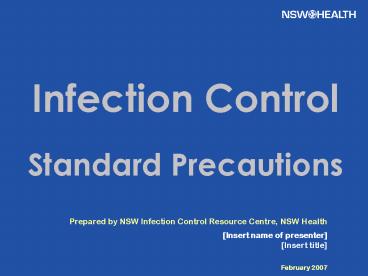Project Overview - PowerPoint PPT Presentation
1 / 17
Title:
Project Overview
Description:
A definition and overview of Infection Control Precautions & the two ... During venepuncture? Cleaning a patient incontinent of diarrhoea? Irrigating a wound? ... – PowerPoint PPT presentation
Number of Views:92
Avg rating:3.0/5.0
Title: Project Overview
1
Infection Control Standard Precautions
Prepared by NSW Infection Control Resource
Centre, NSW Health Insert name of
presenterInsert title February 2007
2
Introduction
- This PowerPoint presentation is designed to
provide the viewer with current information to
assist them apply Infection Control Precautions.
The information covered in this presentation
includes - A definition and overview of Infection Control
Precautions the two-tiered approach - Definition of Standard Precautions
- Standard Precautions
- Application - example of poster
- Application When to apply?
- Personal Protective Equipment (PPE)
- Additional resources for information
- Points to remember
This presentation is part of a series and should
be used in conjunction with the other components
of the module and series.
3
Infection Control Process- The two-tiered
approach
- NSW Health endorse a two-tiered approach to
infection control - The first tier includes those precautions
designed for the care of all patients, regardless
of their diagnosis or presumed infection status - These precautions are known as Standard
Precautions and constitute the minimum acceptable
level of practice in infection control. - The second tier includes precautions that are
applicable only for the care of specified
patients and are known as Additional
(Transmission Based) Precautions.
4
Standard Precautions-Tier one (1)
- These are the minimum standard of precautions to
be applied to all people accessing health care
services regardless of their diagnosis or
presumed infectious status, there-by reducing the
risk of transmission of organisms from both
recognised and unrecognised sources. - These precautions apply to
- blood and all body substances (except sweat)
- acutely or chronically non-intact skin and
- mucous membranes including eyes
5
You must use Standard Precautions when
Handling blood or body substances
There is risk of splash to mucous membranes
6
You must use Standard Precautions when
Providing care which induces coughing
Performing invasive procedures such as
cannulation and catheterisations
7
You must use Standard Precautions when
There is risk of hands being contaminated with
blood or body substances
Before and after patient contact, perform hand
hygiene
8
The use of Standard Precautions includes
Hand hygiene practices including washing of hands
before and after each patient contact
Cover any cuts before commencing work
9
The use of Standard Precautions includes
Using PPE for risk of splash to clothes with
blood and body substances
Safe handling and disposal of sharps
10
The use of Standard Precautions also includes
- The use of aseptic technique
- Getting vaccinated and check your immunity to
vaccine preventable diseases - Reporting all occupational exposures
- Keeping a clean environment
11
Standard Precautions- Tier 1
Example of the poster- Standard Precautions
12
Recommendations for use of personal protective
equipment (PPE)
Prepared by Insertname of presenterInsert
titleInsert Branch name February 2005
13
Standard Precautions-PPE
- Assumes all blood and body fluids as
- Potentially infectious
- Involves the use of protective barriers
- and safe work practices
- PPE choice designed to
- minimise contact with potentially
- Infectious blood and body fluids
14
PPE for Standard Precautions (1)
- GLOVES - must be worn on both hands and must be
used in situations where the health care worker
is potentially exposed to blood and/or body
substances - GOWNS - A fluid-resistant gown/apron, made of
impervious material must be worn during any
procedure where there is a likelihood of splashes
or contamination with blood or other body
substances
15
PPE for Standard Precautions (2)
- MASK AND PROTECTIVE EYEWEAR OR A FACE SHIELD
must be worn while performing any procedure where
there is a likelihood of splashing or splattering
of blood or body substances.
16
What type of PPE would you wear?
- Showering or bathing a patient?
- Suctioning oral or tracheal secretions?
- Transporting a patient in a wheelchair?
- Responding to a dislodged chest drain where
visible blood is spurting out? - During venepuncture?
- Cleaning a patient incontinent of diarrhoea?
- Irrigating a wound?
- Taking vital signs?
?
17
Where do I go for more information?
- Check local Infection Control Policy Manual
- Check with facility or Area Infection Control
Nurse - NSW Health Website http//www.health.nsw.gov.au/qu
ality/hai/

